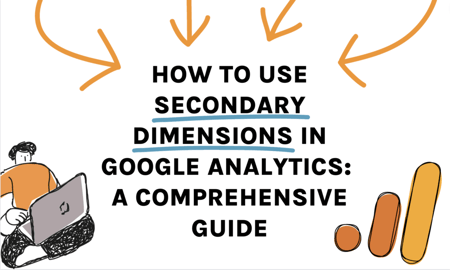Unlocking Search Engine Optimization Success with Advanced Analytics and Secondary Dimensions
Unlocking Search Engine Optimization Success with Advanced Analytics and Secondary Dimensions
Blog Article
Enhance Your Information Analysis Using Additional Measurements
The true depth of insights lies in the integration of second measurements. The calculated usage of second dimensions raises evaluation beyond the surface area level, assuring a wide range of untapped possible waiting to be discovered.
Understanding Secondary Dimensions
Second measurements in data evaluation describe additional qualities or metrics that provide deeper insights when incorporated with main data dimensions, enhancing the overall understanding of the dataset. These extra dimensions provide an even more comprehensive view of the data, allowing analysts to uncover surprise patterns, connections, and fads that may not be evident when only taking into consideration primary measurements.
By integrating secondary dimensions into data evaluation, analysts can acquire a much more nuanced understanding of the elements affecting the key metrics. As an example, in marketing evaluation, key dimensions could consist of standard client demographics like age and gender, while secondary dimensions might encompass variables such as purchasing behavior, preferences, or geographical location. By combining these primary and second dimensions, analysts can develop much more detailed customer profiles, enabling even more targeted and effective advertising techniques.
Furthermore, additional dimensions can aid in determining connections between various variables, resulting in more precise anticipating modeling and decision-making. They make it possible for experts to check out information from numerous perspectives, enhancing the understandings drawn from the dataset and inevitably boosting the high quality of analysis and calculated suggestions.
Advantages of Second Dimensions
When thinking about information evaluation, including second measurements provides a wide range of benefits that substantially boost the deepness and breadth of understandings obtained from primary data dimensions. By adding additional measurements such as time, area, or market information to the analysis, researchers can gain a more thorough understanding of the key information factors.
Furthermore, additional measurements can additionally assist in segmenting data, permitting a much more detailed analysis of certain parts within the key data. This segmentation can cause even more targeted approaches and activities based on the unique attributes of each section. Additionally, additional measurements can aid in verifying searchings for from main data dimensions, giving an extra durable and reliable basis for decision-making.
Basically, the advantages of incorporating second dimensions into information analysis are invaluable, using richer understandings and making it possible for more enlightened decision-making processes.
Implementing Secondary Measurements Efficiently
Efficient application of second measurements in information evaluation requires a critical strategy that maximizes the energy of additional contextual information. When integrating additional dimensions, it is vital to align them with the key dimensions to obtain much deeper understandings into the information. Begin by plainly defining the objectives of the evaluation to establish which secondary dimensions will give the most pertinent context. It is necessary to select second measurements that complement the main information without causing sound or complication in the analysis.
Furthermore, consider the scalability of the secondary measurements throughout different datasets or evaluations. By carrying out additional dimensions successfully, analysts can boost the depth and precision of their information evaluation, leading to even more enlightened decision-making and actionable insights.
Advanced Techniques With Second Measurements
For an extra sophisticated method to information evaluation, including additional measurements can considerably elevate the deepness of understandings gained. Advanced methods with additional dimensions involve even more intricate techniques to extract beneficial information from data sets. One such technique is cohort evaluation, where information is fractional based upon certain features or actions to track patterns gradually. This method enables a much deeper understanding of how different teams interact and advance with your item or service.
An additional innovative technique is regression evaluation, which assists recognize relationships in Website between variables and exactly how my latest blog post they affect each other. By adding additional dimensions, such as market information or individual behavior, to regression models, you can reveal more nuanced insights and make even more exact predictions.

Study: Additional Dimensions in Action

In another situation, a medical care copyright leveraged second dimensions to optimize source allocation. By evaluating client outcomes in connection with geographical location, the organization identified areas with high readmission prices. This caused the implementation of targeted intervention programs in those regions, eventually improving patient care and lowering medical care prices.
These study illustrate the power of additional dimensions in revealing useful insights that drive tactical decision-making. By delving deeper into data evaluation past key metrics, organizations can obtain a much more extensive understanding of their procedures and clients, causing even more effective and informed business strategies.
Final Thought
To conclude, the incorporation of secondary dimensions in data analysis is essential for obtaining a detailed understanding of underlying fads and aspects. By making use of techniques such as mate evaluation and regression analysis, organizations can uncover covert understandings and make more informed choices. Additional measurements add deepness and breadth to data evaluation, permitting organizations to check out data from several point of views and drive much more reliable end results.
In advertising and marketing evaluation, primary measurements could include fundamental customer demographics like age and gender, while second dimensions could encompass variables such as purchasing habits, preferences, or geographic area.When considering data analysis, integrating second measurements provides a plethora of advantages that dramatically enhance the deepness and breadth of insights acquired Discover More from main data dimensions.Moreover, secondary measurements can additionally assist in segmenting information, enabling for an extra comprehensive evaluation of certain parts within the key data. In addition, additional dimensions can aid in verifying searchings for from main data measurements, offering a much more robust and reliable basis for decision-making.
When integrating secondary dimensions, it is vital to align them with the primary dimensions to get much deeper understandings right into the data.
Report this page